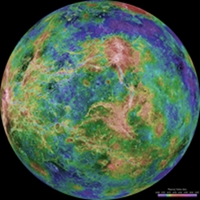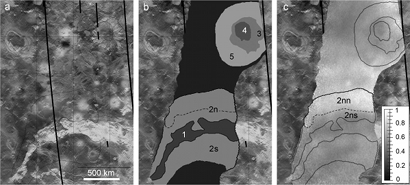Venus Express unearths new clues to the planet's geological history
16 May 2012
ESA's Venus Express has been used to study the geology in a region near Venus' equator. Using near-infrared observations collected by the Venus Monitoring Camera (VMC), scientists have found evidence that the planet's rugged highlands are scattered with geochemically more evolved rocks, rather than the basaltic rocks of the volcanic plains. This finding is in agreement with previous studies, which used data from the spacecraft's Visible and Infrared Thermal Imaging Spectrometer (VIRTIS) to map the planet's surface in the southern hemisphere.
 |
|
Radar image of the surface of Venus. Credit: NASA/JPL/USGS |
Investigations into the nature of Venus' surface are complicated by the fact that the surface is concealed behind a dense covering of clouds. Since the 1980s, radar instruments on board orbiting spacecraft have been used to peer through these clouds to gain insight into the texture of the surface. However, in order to understand how Venus has evolved, geologists want to 'dig a bit deeper' and study the composition of its rocks – information that radar imaging can't provide.
They're eager to learn if geological features revealed in radar images, such as steep-sided domes and rugged highland terrain (called tesserae), contain materials that are rich in silicates, such as 'felsic rocks'. On Earth, most felsic rocks – the most common of which is granite – formed in a water environment. This makes them particularly interesting with regards to planetary evolution.
Since Venus Express began its observations, scientists are now starting to unearth the planet's geology. The near-infrared channels of the VMC and VIRTIS instruments have measured the intensity of 1 micron-wavelength radiation, which is dependent upon the surface temperature and emissivity of the rocks. It's the latter that is important here, as it depends on several factors, including the surface texture and mineral composition.
In a new study, the first findings about the geology of Venus based on VMC data have been published. The study, which was led by Alexander Basilevsky from the Vernadsky Institute of Geochemistry and Analytical Chemistry in Moscow, Russia, analysed the rugged highland terrain called Chimon-mana Tessera and its surrounding volcanic plains. This region was chosen for the VMC study because its equatorial position prevented solar light from skewing the data; by observing the night-side of Venus and keeping within low latitudes (40 degrees above and below the equator), the planet eclipsed the Sun from the spacecraft.
Furthermore, the team needed to eliminate the effects that variations in the surface temperature may have had on the intensity of 1-micron radiation, so that any changes could be attributed to emissivity. Here, Venus' thick atmosphere played a helping hand, as the surface temperature has very little diurnal, seasonal or latitudinal variations; it is almost entirely a function of surface elevation. Therefore, the scientists compared observations of Chimon-mana Tessera with the nearby Tuulikki volcano, which lies 10 degrees north of the equator, as both summits are at a similar elevation (about 0.5-1 km above the plains). "Tuulikki is a basaltic volcano and we thought it presented a good scientific control for altitude," says Basilevsky.
 |
|
Chimon-mana Tessera and areas studied with VMC. (From A.T. Basilevsky et al. 2012) |
However, the 'control' volcano had a surprise in store for the team: an unexpected decrease in emissivity at its summit compared to the surrounding plains. "It was only when we found the lower emissivity that we looked at the volcano with maximum resolution and discovered a steep-sided dome feature at the summit," says Basilevsky.
The decrease in emissivity found in this steep-sided dome feature is consistent with the presence of geochemically more evolved rocks, such as felsic rocks. Furthermore, the team also found a decrease in emissivity of the surface material in the original target area, the Chimon-mana Tessera. Their conclusions, which support the presence of felsic materials on Venus, are in agreement with the earlier VIRTIS studies. "While VIRTIS and VMC have different strengths, they have complemented each other perfectly here by reaching a common conclusion while studying different regions of the planet’s surface," says Håkan Svedhem, ESA Venus Express Project Scientist. The team says that their findings aren’t compromised by the fact that the volcano turned out to be a poor control region for the effects of altitude, as the mineralogical composition clearly plays a more important role. "The winds are expected to be stronger at higher altitudes, blowing away the small grains and leaving behind coarser material that exhibits greater emissivity. Therefore, the effect of elevation, if any, should be an increase in emissivity," explains Eugene Shalygin from the Max Planck Institute for Solar System Research in Katlenburg-Lindau, Germany. "However, we detected a decrease in emissivity at Chimon-mana Tessera and the summit of the volcano, which may be caused by a change in mineralogical composition," he continues.
The jury is still out on whether the felsic rocks on Venus, if they do indeed exist, were created in a water environment, similar to the process that formed most of these materials on Earth. But it is in an enticing possibility, comments Basilevsky. "This is not the only way of forming felsic materials, but planetary geologists, like myself, are eager to find more similarities between Earth and Venus," he says. However, he also points out that the Tuulikki volcano, which also showed decreased emissivity at its summit, formed late in the geologic history of Venus, when there couldn’t have been any oceans on the planet. "If there are felsic materials on the summit of Tuulikki, then these particular rocks clearly formed without water," says Basilevsky.
Related publications
A.T. Basilevsky et al., "Geologic interpretation of the near-infrared images of the surface taken at the Venus Monitoring Camera, Venus Express", 2012, Icarus, 217, 434-450. doi: 10.106/j.icarus.2011.11.03
Notes for editors
The study reported here is based on measurements of the night-side thermal emission from the surface of Venus taken with the Venus Monitoring Camera (VMC).
VMC takes images in four spectral channels, covering ultraviolet to near-infrared wavelengths; one of these, centred at 1.01 microns, registers the night-side thermal emission from the planet's surface.
Venus Express, Europe's first mission to Earth's twin world, is investigating the nature of our closest planetary neighbour. Launched from the Baikonur Cosmodrome in Kazakhstan on 9 November 2005 upon a Soyuz-Fregat launcher, it was inserted into Venus orbit on 11 April 2006, and is currently the only spacecraft in orbit around the planet. It carries a payload comprising a combination of spectrometers, spectro-imagers and imagers covering a wavelength range from ultraviolet to thermal infrared, a plasma analyser and a magnetometer.
Contacts
Alexander Basilevsky
Vernadsky Institute of Geochemistry and Analytical Chemistry, Moscow, Russia
and Max-Planck-Institut für Sonnensystemforschung, Katlenburg-Lindau, Germany
Email: alexander_basilevsky![]() brown.edu
brown.edu
Eugene Shalygin
Max Planck Institute for Solar System Research
Katlenburg-Lindau, Germany
Email: shalygin![]() mps.mpg.de
mps.mpg.de
Håkan Svedhem
ESA Venus Express Project Scientist
Research and Scientific Support Department
Science and Robotic Exploration Directorate
ESA, The Netherlands
Email: hakan.svedhem![]() esa.int
esa.int

